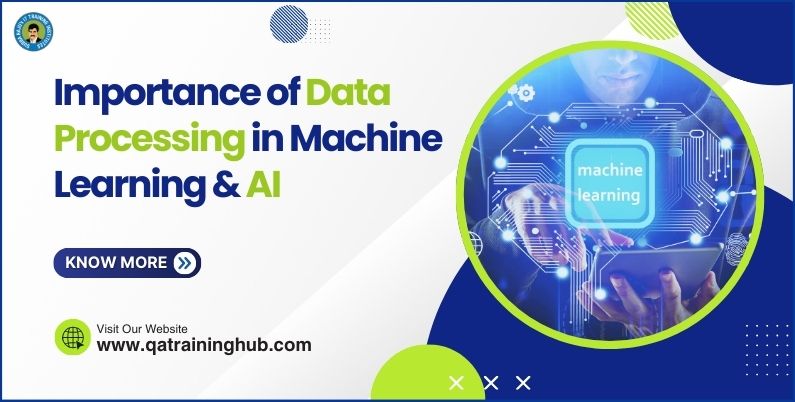
Crucial Role of Data Processing in AI & Machine Learning
Machine Learning (ML) and Artificial Intelligence (AI) are leading the way in innovation, powering things like predictive analytics in today’s rapid technology world. At the core of these powerful technologies is data—raw, unprocessed, and often disorganized. Converting raw data into helpful insights involves a complex process known as data processing. This detailed guide explores the Importance of Data Processing in Machine Learning & AI, highlighting its crucial role in creating models that are accurate, efficient, and strong.
Understanding Data Processing
Data processing is a series of steps that change raw data into something usable. This includes collecting, cleaning, combining, changing, and simplifying the data. Each step is important to make sure the data going into ML and AI models is accurate, steady, and useful. Doing this well improves the data’s quality, which means the models work better and faster.
Why Data Processing is Crucial
Quality Assurance: High-quality data is crucial for trustworthy AI models. Poor-quality data can cause wrong predictions and insights, making the AI system less dependable Data processing gets rid of mistakes, fixes errors, and fills in missing information, making sure the data is trustworthy.
Improved Model Performance: Well-handled data improves how ML algorithms work. When data is clean and organized, algorithms can Identify patterns better, making models more accurate and adaptable.
Reduced Computational Costs: Effective data processing can significantle reduce computer expenses. By getting rid of unimportant or duplicated information, the dataset becomes smaller, making it easier and cheaper to handle.
Enabling Feature Engineering: Feature engineering, which involves using knowledge in a specific field to create features that improve ML algorithms, depends a lot on properly handled data. When data processing is done well, it helps pull out useful features, making models perform better.
Compliance and Security: Data processing makes sure that data follows important laws like GDPR. It also involves making sensitive information anonymous, which boosts data security and privacy.
Key Steps in Data Processing
Data Collection: Collecting data can happen in different ways, like typing it in directly, using sensors, scraping the web, or accessing databases. How good and related the collected data is sets the groundwork for the next steps in processing it.
Data Cleaning: This step involves removing or correcting inaccuracies, handling missing values, and eliminating duplicates. Techniques used include filling in missing values, spotting outliers, and making sure data is on the same scale.
Data Integration: Bringing together data from various sources to create a single view. This often involves sorting out differences in data formats and getting rid of duplicates.
Data Transformation: Converting data into a format that’s good for analyzing. This could mean making sure it’s all on the same scale, putting it in a standard format, or changing categories into numbers.
Data Reduction: Making the data simpler without losing the important information. This could involve techniques like dimensionality reduction, using things like Principal Component Analysis (PCA), or choosing only the most important features.
Practical Examples of Data Processing in ML and AI
Natural Language Processing (NLP): In Natural Language Processing (NLP), data processing includes breaking text into pieces (tokenization), reducing words to their root form (stemming), ensuring words are in their dictionary form (lemmatization), and getting rid of common words that don’t carry much meaning (stop words). These steps are important for changing raw text into a format that ML algorithms can learn to do tasks such as understanding emotions in text or translating languages.
Image Processing: In computer vision tasks, processing data involves resizing images, making sure they’re all on the same scale, and using techniques like rotating, flipping, and scaling to add variety. These steps make the model stronger and work better.
Time Series Analysis: Data processing for time series includes dealing with missing time points, making the data smoother, and pulling out features like average trends over time. Making sure time-series data is handled well is crucial for forecasting models to guess things like stock prices, weather, or sales trends.
Challenges in Data Processing
Volume and Variety: The huge amount and different kinds of data out there today can feel like a lot. Handling big sets of data that have structured parts, semi-structured parts, and bits that aren’t organized takes smart methods and strong computers.
Data Quality Issues: Inconsistent, incomplete, or noisy data can pose significant challenges. Developing robust methods to clean and preprocess such data is crucial for effective ML and AI applications.
Real-time Processing: Lots of applications need to process data as it comes in, which can be hard because it has to be done fast and well. Doing this in real-time is critical for applications like fraud detection, autonomous driving, and real-time analytics.
Ethical and Legal Considerations: Making sure data processing follows the rules and is ethical is really important. This means keeping data private, getting permission to use it, and being clear about how it’s used.
Tools and Techniques for Data Processing
Many tools and techniques have been created to help process data for ML and AI. Some of the popular ones include:
Pandas: A powerful Python library used for handling and analyzing data, offering the necessary tools and functions to tidy up, convert, and examine data effectively.
Apache Spark: Spark is a tool for processing large amounts of data all in one place. It’s good for handling big data because it can work with data quickly without needing to store it all first.
TensorFlow and PyTorch: Although mainly used to create ML models, these frameworks also come with tools for preparing data, such as libraries for processing images and text.
SQL and NoSQL Databases: Databases such as MySQL, PostgreSQL, MongoDB, and Cassandra offer strong features for storing and finding data, helping with different data processing jobs.
Future Trends in Data Processing
Automated Data Processing: Advances in AI are making data processing more automated, which is expected to reduce the manual work needed to clean and get data ready. AutoML tools are already making progress in this direction.
Edge Computing: As more IoT devices become common, processing data where it’s collected (at the edge) is getting more crucial. Doing this reduce down on delays and the amount of data that needs to be sent, making it easier to process data in real-time.
Privacy-preserving Data Processing: Approaches like federated learning and differential privacy are becoming more popular, allowing data to be processed and models trained without giving up people’s privacy.
Graph Data Processing: As the significance of connections between data points increases, processing graph data is becoming more important. Tools and frameworks for managing data structured as graphs are expected to continue developing.
Integration with Blockchain: Blockchain technology can make data processing more secure and transparent, particularly in situations where ensuring data integrity and being able to audit it are really important.
Conclusion
At QA Training Hub, we understand that the Importance of Data Processing in Machine Learning & AI is crucial. The effectiveness of ML and AI models depends heavily on the quality and readiness of the data they’re trained with. By prioritizing thorough data processing methods, we ensure that our models are not just precise but also strong and trustworthy.
The Importance of Data Processing in Machine Learning & AI lies in its ability to transform raw data into a valuable asset. It improves quality assurance, makes models work better, reduces computer costs, and improves compliance and security. Good data processing is important all through the AI process. It makes sure that the data going into models is neat, dependable, and relevant, leading to better predictions and understanding.
As AI advances, the methods and tools for processing data will also change. Keeping up with these changes is crucial. At QA Training Hub, we focus on giving our students the most up-to-date understanding and abilities in data processing, so they’re ready to handle real-world problems.
Join QA Training Hub to delve deeper into the Importance of Data Processing in Machine Learning & AI and learn how to utilize its power to drive innovation and success in your AI projects. With our thorough training programs, you’ll acquire the skills necessary to turn data into actionable insights, guaranteeing your success in the field of machine learning and artificial intelligence.


